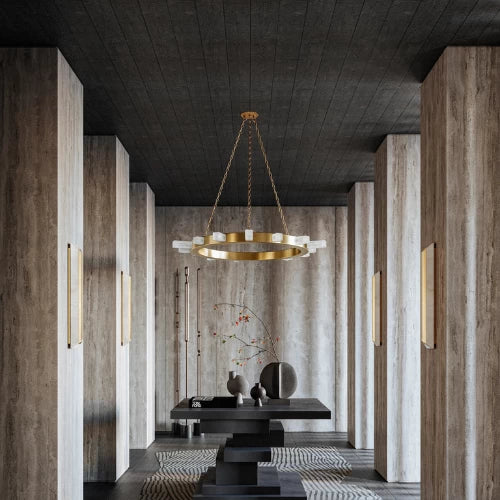Chandeliers have long been a statement piece in interior design. They create an immediate focal point, illuminating a room while adding a touch of elegance and style. This guide will explore the world of modern chandeliers, offering insightful advice on how to choose the perfect lighting fixture for your space.

1. Unraveling the Charm of Chandeliers
A chandelier is an ornamental light fixture that hangs from the ceiling and features multiple lamps, often in multiple tiers, used primarily for ambient lighting. Chandeliers have evolved from traditional, crystal-encrusted designs to more contemporary, sleek aesthetics, meeting the demands of various design styles and preferences.
1.1. Understanding the Basics
At its core, a chandelier is a suspended light fixture that creates a statement in any room, from the dining room and living room to the bedroom and even the patio. It's worth noting that chandeliers and pendant lights are distinct, although they might sometimes seem similar. The former typically has multiple light sources connected by a branched frame, while the latter usually includes a single light source hanging from a wire or suspension system.
1.2. Modern Interpretations
Modern chandeliers challenge the traditional concept of chandeliers, innovatively reinventing design and style. They can range from minimalist and mid-century inspired to opulent and avant-garde, offering a myriad of options to suit various interior design preferences.
2. Navigating Chandelier Styles
One of the most thrilling aspects of choosing a chandelier is discovering a style that complements your home's design. From modern and contemporary to rustic and industrial, there's a chandelier style for every home.
2.1. Modern Chandelier Design
Modern chandeliers are known for their aesthetic appeal and functionality. These designs often feature clean lines, geometric patterns, and a minimalist approach, making them suitable for various interior decorating styles.

2.2. Contemporary Chandelier Design
Contemporary chandeliers break away from traditional styles, offering innovative and minimalist designs that reimagine how chandeliers can be used in everyday settings.

2.3. Rustic and Farmhouse Chandelier Design
Rustic chandeliers emphasize simplicity and naturalism, often incorporating materials like wood and wrought iron. Similarly, farmhouse chandeliers offer a hint of nostalgia, with bare Edison-style bulbs, aged wood, and metal accents.

2.4. Industrial Chandelier Design
Industrial chandeliers use exposed wood and metal to evoke images of lighting fixtures used in factories or industrial settings.

3. Exploring Chandelier Shapes and Finishes
Beyond style, chandeliers also come in various shapes and finishes, adding another layer of customization to your lighting options.
3.1. Chandelier Shapes
Chandeliers can take up different forms, from rectangular and round chandeliers to cluster and sputnik chandeliers. They also come in caged and globe designs, providing diverse options to fit your aesthetic preferences and spatial requirements.

3.2. Chandelier Finishes
Chandelier finishes can either coordinate or contrast with your room's furnishings and other light fixtures. For instance, a chrome chandelier can pair well with bronze wall sconces, provided they share similar design styles. Other popular finishes include bronze, gold, and silver.
4. Lighting Function of Chandeliers
Beyond their aesthetic appeal, chandeliers also serve a crucial function: lighting up your space. Chandeliers can provide uplighting, downlighting, or ambient lighting, depending on their design.
4.1. Uplight and Downlight Chandeliers
Uplight chandeliers focus light upwards, providing reflected ambiance around a room, while downlight chandeliers offer direct, focused light below, ideal for rooms needing plenty of direct, focused light along with ambient light.
4.2. Ambient Lighting
Most chandeliers excel at creating ambient lighting due to their emphasis on diffused, non-direct light. However, they're not typically ideal for providing task lighting.
5. Chandelier Positioning and Installation Height
Positioning and installation height significantly affect the look and functionality of your chandelier. Ideally, the chandelier should be as centered as possible in the room for aesthetic reasons, light distribution, and visual balance.
5.1. Positioning a Chandelier
In a dining room, a chandelier should hang approximately 30 inches above the dining table surface, while for rooms with high ceilings (9 feet or higher), add about 3 inches for each additional foot of ceiling height.

5.2. Installation Height
Ensure you consider the line of sight and safe clearance when installing a chandelier. A light fixture that blocks your view or causes frequent head bumps quickly loses its appeal.
6. Chandelier Brightness
The ideal lumen count for a chandelier depends on the room's square footage. For instance, a dining room needs about 300-400 total lumens per 100 square feet.
7. LED Chandeliers
LED chandeliers are a modern take on traditional chandeliers, offering sleek designs and efficient lighting. They come in a variety of sizes, with the number of light bulbs varying depending on the chandelier size.

8. Understanding Your Space
Before choosing a chandelier, consider the dimensions, ceiling height, and existing decor of your space. This understanding will guide you towards the most suitable lighting fixture for your specific needs.
9. Choosing Chandeliers for Different Rooms
Chandeliers can be a great addition to any room, including dining rooms, bedrooms, entryways, and even small rooms. However, each room has specific considerations and rules when it comes to choosing and installing a chandelier.
10. Factors to Consider
When selecting a chandelier, consider factors beyond aesthetics, such as the lighting requirements of the room, the chandelier's intended purpose, and how it integrates with your overall interior design scheme.
11. Tips for Choosing the Perfect Lighting Fixture
When selecting a chandelier, assess the level of illumination needed for the space, balance the chandelier's size with the room's dimensions, opt for high-quality materials, and consider the chandelier's placement.






